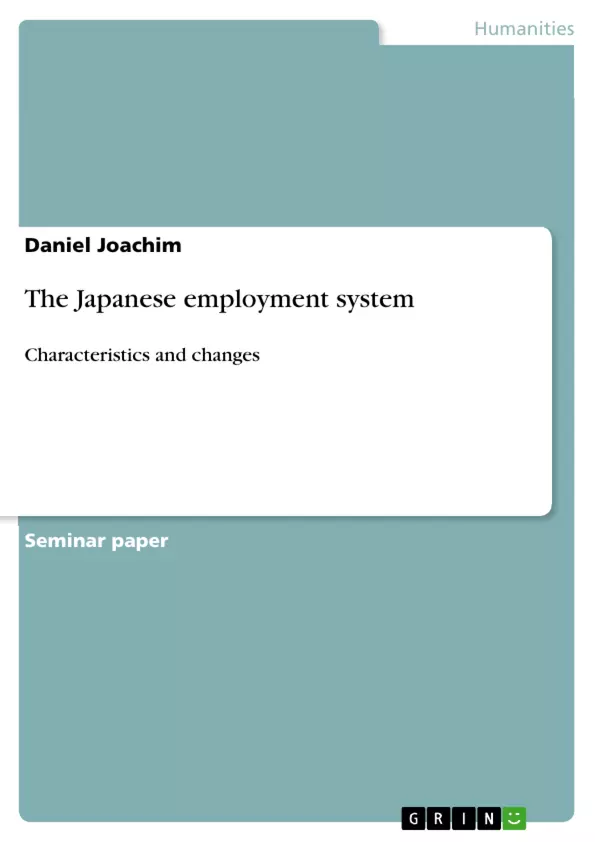After Japan recovered from the disastrous defeat of World War II, its enormous economic
growth provided a series of questions to the world’s leading economists. With constant
growth rates over 11% on average in the 1960s, Japan had the world’s second largest
GDP.
Seeking explanations and reasons for this phenomenon, soon a couple of important
influences on the Japanese economy were found. The increased demands on Japanese
products during the conflicts in Vietnam after the Second World War (which led to the
Vietnam War 1964-1973) and the Korean War 1950 to 1953 as well as the government aid
for selected industries and protective duty accelerated its growth, which exceeded all
former expectations1.
Another important element of the Japanese prosperity was met with the Japanese-style
employment system2. What would primarily influence the image of the Japanese to the
further decades, the industrious, never sleeping blue-collar and white-collar workers,
fulfilling a life for the company in a state of mutual dependence, is the result of an
elaborate employment system.
And in fact, lifetime employment, a predetermined career path and the seniority-based
wage system were established to commit the regular workers to "their“ company, while the
temporary workers still did not reach a similar status.
This "Japanese Model“, as several authors call it, is subject to constant change. Even
though the system was never fixed, it changed its surface not before the "collapse of the
bubble“ in 1990.
Shortly after this prolonged economic recession, which forced every industrialised country
to undertake economic restructuring, Japan was able to recover very fast through strict
rationalisation and a revision of its employment system. Today, Japan has changed. Still the second largest economy of the world, it has to
confront an economic growth close to 2%. With this comes a call for a more flexible
employment system which still has to pay the regular workers who many years ago were
attracted with the seniority-based wage system reflecting the workers higher needs in
subsequent years. Furthermore, the new generation of workers is organised in unions and
knows their value to the market, and would not agree earning half the sum a senescent
worker does.
Inhaltsverzeichnis (Table of Contents)
- Preface
- Subject of Analysis
- The Japanese Employment System at a Glance
- Japanese Unions and their Impact
- The Genesis - 1920s to 1945
- The Genesis - 1945 to 1973/74
- The Genesis - 1974 to 1990
- Recent Changes
- Pros and Cons
- In Times of High Growth and a Labour Shortage
- In Times of Low Growth and a Labour Oversupply
- Outlook
- Bibliographies
Zielsetzung und Themenschwerpunkte (Objectives and Key Themes)
This paper examines the evolution of the Japanese employment system from the early 1920s to the present, focusing on the impact of the "collapse of the bubble" in 1990. The paper aims to interpret recent trends in the system and analyze how this event significantly altered traditional lifetime employment and seniority wage structures.
- Evolution of the Japanese employment system since the 1920s
- The impact of the "collapse of the bubble" in 1990
- The role of Japanese unions in shaping the employment system
- The transition from lifetime employment and seniority wages to a more flexible system
- The challenges of balancing the needs of older workers with the expectations of younger generations
Zusammenfassung der Kapitel (Chapter Summaries)
The preface provides an overview of Japan's post-war economic growth and highlights the significant role of the Japanese employment system in achieving this success. The paper introduces the concept of lifetime employment, seniority-based wages, and the "Japanese Model" and notes that this system has undergone continuous change, particularly after the economic recession of the early 1990s.
The "Subject of Analysis" chapter outlines the paper's scope, focusing on the development of the Japanese employment system and the impact of the 1990 economic downturn. It also touches upon the influence of trade unions and acknowledges limitations in the paper's scope due to the complexity of the subject matter.
The chapter titled "The Japanese Employment System at a Glance" delves into the history of the Japanese employment system, exploring its development through various historical periods. This section examines the evolution of the system, highlighting key factors such as the influence of unions and the changes brought about by economic fluctuations.
The "Pros and Cons" chapter analyzes the benefits and drawbacks of the Japanese employment system, considering its impact during both periods of high economic growth and periods of low growth and oversupply of labor. This section likely examines the strengths and weaknesses of the system in different economic environments.
Schlüsselwörter (Keywords)
This paper focuses on key concepts related to the Japanese employment system, including lifetime employment, seniority-based wages, the "Japanese Model", the role of unions, economic growth, the impact of the "collapse of the bubble" in 1990, and the transition to a more flexible employment model. The paper examines the historical development of the system, its evolution in response to economic changes, and the challenges of adapting to a new economic landscape.
- Quote paper
- Daniel Joachim (Author), 2006, The Japanese employment system, Munich, GRIN Verlag, https://www.grin.com/document/116050



